The amount of consumed "on the soul" (or rather the body) of alcohol in some cases very critical (e.g. for drivers). In many countries of Europe (Germany. Finland. Poland and others) a few years ago appeared in the free market detectors alcoholic vapors, or so-called "breathalyzers" (Roadtest). Of course, this is not a professional instrument, but they allow you to control "smell" and to assess their condition after taking something "warming". Options of breathalyzers. manufactured by various companies, but similar devices of domestic production available for sale yet.
"Breathalyzer" (Fig.1) analyzer is a break of alcohol and toluene, xylene and other volatile organic compounds. In the upper part of the device is replaceable plastic tube, which is designed for injection air mouth (into the device). When the power is heard briefly the audio signal (peak-peak), 1 ...with 2 - second (similar to the first), and the indicator (below the numbers) flashes the word "Wait" (wait). During this period duration 10...12 occurs with the occurrence of the sensor to the measuring mode. After that, the third sound signal suggests. that the device is ready for (taken to the analysis of air). The LCD will "Wait" is replaced on "Ready".
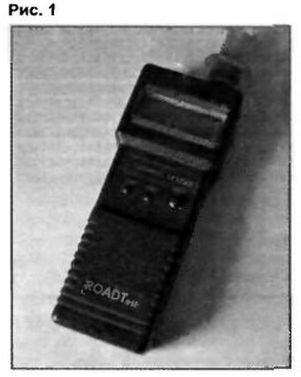
If after the third signal is not blowing into a tube*, the device accepts the same the air, which he has already analysed, and, finding no differences, for 10 to 12... with gives a negative verdict (in medicine is considered a negative result good, not confirming the diagnosis). This status is indicated on the indicator the word "OFF" (no signal). The system can turn off automatically turns the power off of the device after about 1.5 minutes (to save batteries). When the breath detected the presence of alcohol vapors, the device outputs on the digital indicator readings (max 4000 - you just forget about the car) and reiterated its the study of infinite signals, which can disable either the "Reset" button (test first), or "Power".
The appliance has a special sensor to the presence of impurities in the air type TGS-2620 (Taguchi Gas Sensor - Fig.2) made by Figaro Engineering Inc. (Japan). The discoverer of these sensors in 1962 became a Japanese inventor N. Taguchi. Most sensors TGS (TGS 822, TGS 2620) made on the basis of tin oxide. The resistance of these sensors DC in normal air is high, or when the presence in the air of contaminants (vapors of organic origin) resistance sharply reduced.
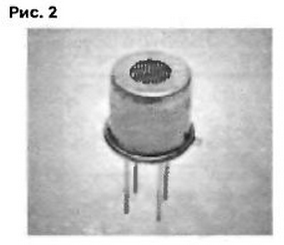

The dependence of the relative resistance of the sensor from the gas concentration is shown in Fig.3. The sensors are not universal, for example, sensor the alcohol vapors will not react to the presence of freon. Typical operating circuit of the sensor shown in Fig.4.
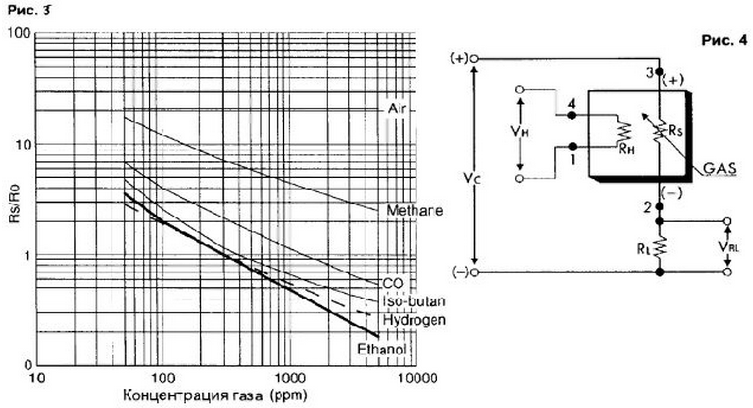
If you connect this sensor to the comparator (comparison device), the latter will pick up the change the resistance of the sensor and enables the alarm. For efficient operation of the sensors requires a constant voltage of about 5 V. therefore, such a device can successfully be used with Autonomous power supply, for example, from 3-4 miniature batteries AAA. The only minus is the cost of the sensors is almost 50 USD. On a similar principle Operates the apparatus, with the only difference being intermediate audio signals and the digital display it has, and shows only two States: drunk (the sound lasts until the power is turned off) or not drunk (no sound).
The scheme of the "Breathalyzer" with the use of sensor TGS-2620 shown in Fig.5.
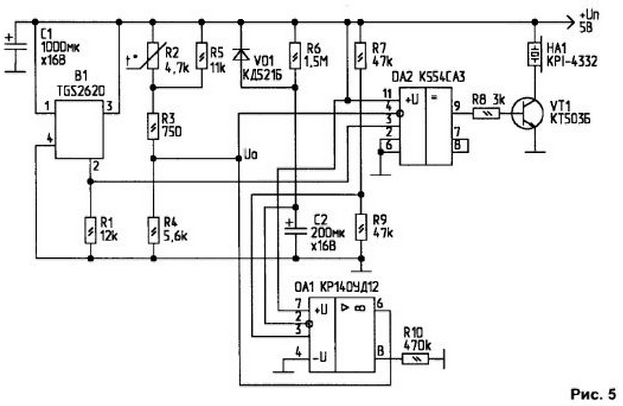
The supply voltage for the heater of the sensor B1 is fed to its output 1 to total the wire connects the output of the heater 4. For processing the output signal the sensor uses a comparator DA2 (CSS), which compares the voltage on their inputs. The non-inverting input of comparator connects to pin 2 of the sensor, and inverting - chain R2-R3-R4-R5, creating a temperature-compensated (for the expense of the thermistor R2) reference voltage U0.
Operational amplifier DA1 with elements VD1, R6, C2, R7, R9 provides a delay of 1...1.5 minutes required to eliminate false positives when power-up and measurements. Without this delay, the device can to enable the audio signal regardless of the presence of alcohol vapors.
When the output voltage V1 under the influence of alcohol vapors with concentrations exceeding this limit, a trigger comparator DA1, a high level at its output provides the enable sound the primer with a built-in generator HA1 or other alarm device.
Without temperature compensating circuits sensor signal could vary 600 3400... RRT for a given value of the concentration of alcohol vapors 1500 ppm (at ambient temperature of 20°C and a humidity of 65%). The dependence of the relative the resistance of the sensor from the ambient temperature are depicted in Fig.6.
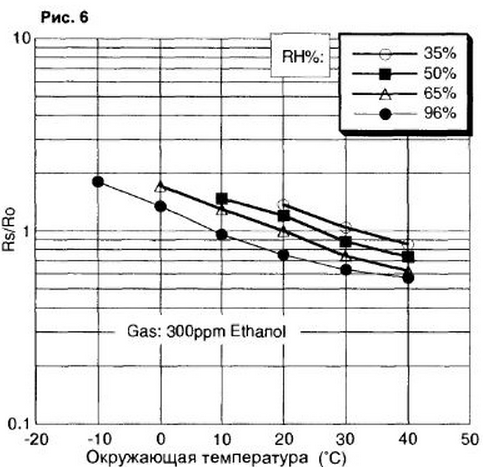
For temperature compensation thermistor is R1. The voltage U0 may vary in the range 2,5...3,2 V At an ambient temperature of +40°C and relative humidity 65% and, respectively, in the range of 1.9...3.1 V at a temperature of -10°C.
Results the use of temperature compensating resistor are presented in the table.
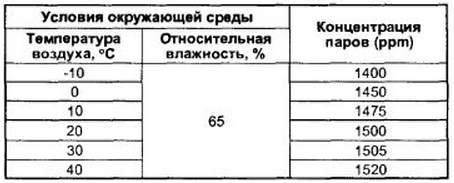
The Capacitor C1 smoothes the ripple voltage during the litany of the device from a network source power. The VD1 diode prevents current leakage of the oxide of the capacitor C2, the Details. Thermistor R1 - type NTC. MMT or similar. Transistor VT1 is replaced by CT, CT, CT with any letter index, DA1 chip - on CRUD, CRUD. Diode VD1 - KD521, KD522 with any letter index. Oxide capacitors CI, C2 - type K50-29 or similar.
A sound emitter HA1 - any with a built-in generator of the AF for voltage 5 12... V. For additional light-signalling parallel to the capsule 1 can connect the led (type ALBM or similar with current up to 10 mA) anode to"+" supply with series connected resistor 470...750 Ohms. The power source of the device (if not using battery) - stable, voltage of 5 V (±5%). Current consumption less than 70 mA (without led indicator). In addition to the sensor TGS-2620. e this scheme can applied sensors Murata company TGS 880, TGS-2181 or TGS-822 (voltage power - 12...15).
Author: A. Kashkarov, G. S. Petersburg






